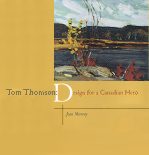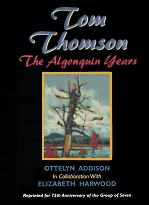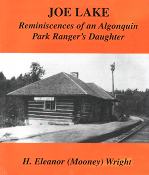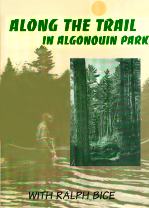|
This book tells the rich history that led to the Park we know today, beginning with early indigenous hunters and gatherers, their displacement by colonist lumbermen, the formation of the Park in 1893, the growth of lodges camps and cottage leases, the challenges faced by early and latter day park superintendents, the development of a multiple-use concept including both regulated logging and recreation, the influence of today’s Algonquin People on the Park and ongoing negotiations about the role they will have within it and much more. Long-time cottager, and director of The Friends of Algonquin Park, Brian Maltman has said, "This is the definitive work on the human history of the Park, and how it has been shaped by the people who explore, work in, live in and love this place." (Softcover, 432 pages) |
 |
|
In 1896 J. R. Booth set out to build a railway from Ottawa to Parry Sound so that goods and grain from Canada's west could reach markets in the north east. For 40+ years one of the key stops along the way was Rock Lake Station (which became part of Algonquin Park in 1911). Beginning as an important source of gravel for the rail bed and later a layover spot for railway workers, Rock Lake soon became a mecca for camping and fishing enthusiasts interested in escaping city life. In its heyday,in the early part of the 20th Century the train was the lifeblood of this little community and trains would allegedly pass every 20 minutes or so. Nearby, the Booth family established a large estate in 1900, which anchored a lively community composed of leaseholders, loggers, and railway workers. Today only a scattered collection of summer leaseholds remain on Rock and Whitefish Lakes and the town site is now a public campground. Rock Lake Station brings to life the history and character of the people who settled here and for a time called it home. (Softcover, 6" x 9", 114 pages) |
 |
|
Rory Mackay's travels began in the mid-1970s as he sought to document the vast cultural resources of Algonquin Provincial Park. During this period he visited most known sites along the Little Bonnechere River and interviewed the children of the original Basin Depot farm settlers who supplied the lumber industry. Rory also studied archival materials such as maps, journals and legislative reports which deepen our understanding of the history of this area. The result of his work is an extensive collection of cultural resource information documenting the development and settlement along the Little Bonnechere River. (Softcover, 6.5" x 9.75", 152 pages) |
 |
|
In 1908 (eleven years after the first train went through Algonquin), Tom McCormick arrived at Brule Lake as an office clerk for McLaughlin's lumber company. Three years later he was married and a year after that his wife gave birth to Margaret Mary. Eighty-one years later that very same Mary McCormick Pigeon gave us this insightful account of the 21 years she lived at Brule Lake .. deep in the heart of Algonquin Park. Although it only has forty pages, it's a treasury of tender recollections and wonderful family photos. This modest little book will take you back to a time of lumber-mills, plentiful lake trout, railway hand-cars, bush-farms, high-laced boots and canvas canoes .. a time that's getting close to being a century ago! (Softcover, 8 1/2 x 11½ inches, 40 pages) |
 |
|
Only three years after leaving Brule Lake, Algonquin and attending Teachers' College, Mary McCormick returned as Mary McCormick Pigeon with her husband Lorne Pigeon. They took up residence at Cache Lake and raised their family there. Mary's Cache Lake recollections span the fourteen years between 1936 and 1950. Her sensitive descriptions include area residents, her sons (Tom and Jon), the Leaseholders' Association, her one-room school, Frank MacDougall, The Highland Inn, Bartlett Lodge, annual regattas and much more. As in the case of her earlier "Born In Brule Lake", Mary's collection of home photographs provide a gold-mine of complimentary images! This book takes one back to a time and place of the first car-born Algonquin cottagers .. which most of us can only guess about. Margaret's wonderful little book definitely makes that jump of imagination a very enjoyable experience. (Softcover, 8 1/2 x 11½ inches, 40 pages) |
 |
|
Every week from the Victoria Day Weekend in late May to Thanksgiving in early October, hundreds of visitors venture to Canoe Lake and visit the Portage Store be they day visitors out for an afternoon paddle, car campers, interior canoe trippers, or those just casually driving by along Highway 60. Very few are aware of the rich history of this venerable institution extending over decades since the original opening in the mid 1930's of Highway 60. This booklet tells that story and is the second in a series of Algonquin Park visitor guides designed to bring to life the 'human history' of the Park .
Author: Gaye I. Clemson ( clemsong@algonquinparkheritage.com ) |
 |
|
Joan Murray has dug deep to discover the emotions that drove Tom Thomson. This book doesn't cultivate the hero myth. Rather, it seeks to examine the driving forces and deciding moments that led Tom to Algonquin Park and Canoe Lake .. to his fate and his fame. While the results of Joan's research have the disturbing chill of reality, they do allow us to better understand and sympathize with the man, as opposed to the myth that grew after his untimely death. One often wonders what would have transpired if on July 8th, 1917 Tom had decided to sleep-in, read a book or prepare some canvases instead of heading out to do some fishing. Would his art have blossomed to greater heights? Or, would it and his life have merely blended into the passage of time? While no book can answer these questions, Joan's book certainly provides a wealth of insight with which to wonder these questions in far greater depth. (Hardcover, 9 x 9½ inches, 109 pages) Author: Joan MurrayCopyright: 1998 by Joan Murray. Published in 1998 by: Dundurn Press ISBN 1-55002-315-2 |
 |
|
Ottelyn Addison (in collaboration with Elizabeth Harwood) has searched-out a detailed description of Tom Thomson's times, life and accomplishments. She's included many personal recollections by Tom's contemporaries ... friends, acquaintances and co-artists. Ottelyn provides the reader with crisp impressions of momemts in Tom's all-too-short life. Letter extracts, journal entries, revealing black and white photographs and some choice full-colour illustrations of some of Tom's most memorable paintings ... all provide an expanded familiarity with Tom's time and place. However as with any artist who painted his feelings rather than writing about them, we are still left wanting more. This book may be one of the best insights of the man who was Tom Thomson. (Softcover, 5½ x 8 inches, 98 pages)
Author: Ottelyn Addison |
 |
|
Eleanor Mooney lived in Algonquin Park as the daughter of a park ranger, from 1928 to the mid 1940's. Her home was a frame cottage located S/E of the old railway bridge that crosses the Joe Lake narrows immediately north of its dammed outlet to Canoe Lake. Eleanor's young life in the park was quite unique, as were those of her family and neighbours. She describes all aspects of living in the park including making preserves from local fruit, attending the Canoe Lake School, her father's work duties, family activities and camping trips. Her book includes a wealth of black and white photographs showing family, community and historical activities ... a glimpse into the lives of a true Algonquin Park family. There are also four pages of hand-drawn "sketch-maps" illustrating the locations of structures that once existed around the area where Joe Lake empties into Canoe Lake. The next time you canoe through this area, take along a copy of this book, slow down and checkout the book's maps and photographs. You'll gain a stronger feel for what the area used to be like! (Softcover, 8½ x 11 inches, 125 pages)
Author: H. Eleanor (Mooney) Wright |
 |
|
It was this past summer (2003) that I came across this book at the Visitor Centre store. I immediately recalled my "paddle-by" and snatched-up a copy. What an eye-opener to the old days and ways! It's a thoroughly enjoyable re-introduction to Algonquin Park by Ralph Bice ... a true "one-of-a-kind". (Softcover, 175 pages, 6 x 9 inches)
Author: Ralph Bice |
 |
|
During the first half of the last century, Algonquin was officially promoted as a leaseholder's opportunity for both cottage and youth camp sites. Rock, Cache, Smoke, Tea and Canoe Lakes were some of the popular areas. Canoe Lake was unique in already being the location of timber-felling, lumber-cutting, railroad loading and the servicing village of Mowat. For the first third of the century, visitors arrived by train at the north end of the lake. The completion of Highway 60 provided access by the lake's south end. Gaye Clemson's 169 page book recollects a lifestyle that otherwise would have faded into forgotten memories. Her focus is on the women that left their marks on the Canoe Lake community over the past century. Gaye generates a nostalgia for a place and time that most of us never experienced or guessed at. The book's numerous black and white photos from the family albums of Canoe Lake "cottagers" effectively put faces to the stories' names. Having read this book, your next paddle up Canoe Lake will be coloured with an understanding of what came before .. the loves, lives and losses of Canoe Lake's last century. This is a kind but haunting account of unique experiences lived by a select few Algonquinites.
Author: Gaye I. Clemson ( clemsong@algonquinparkheritage.com ) |
 |
|
In the spring of 1941, Gertrude Baskerville set our from the Kitchener area with her ailing husband and teenage son to join her brother in establishing a new life on the shores of South Tea Lake. Within a year her husband had died, her son was shipped overseas, and her brother decided that better opportunity lay for him and his family in BC. This is the story of the ‘Lady of Algonquin Park’ who carved out for herself a life in the Algonquin Park wilderness for over 35 years. This little book is specially meaningful for anyone who's either stayed at the Tea Lake Drive-in Campground or fished from the Smoke Creek bridge abutments ... and wondered about the narrow northbound dirt road just east of the bridge. It's at the end of this dirt road that the most unique and blessed part of Gertie's life was lived. Gaye Clemson has written a rich and joyous tale of one woman's life and a side of Algonquin Park that most of us never dreamed about ... a genuine 'must-read' for any Algonquinite!
Author: Gaye I. Clemson ( clemsong@algonquinparkheritage.com ) |
 |
|
Liz Lundell and Beverly Baily toured the eight youth camps in Algonquin Park ... gathering the recollections, descriptions and images that comprise this book. With 120 pages and lots of great colour photos, this 8x11" book is a past-to-present memorial to the commitment, labour, participation and enjoyment that comprise the Algonquin Camp experience. As such, it obviously means the most to people who have spent youthful summers at these camps. However, for Algonquin canoe-campers who have paddled by the camps and witnessed the childrens' activities, laughter and joy from afar ... this book warmly confirms our envious suspicions that we've missed out on one heck of a good time!
Authors: Liz Lundell and Beverly Bailey |
 |
|
This book describes colonization efforts to encourage agricultural settlement in the "Huron Tract" which included what was to later become Algonquin Park. The time period was from 1829 to 1867 and government officials had fallen prey to the myth that the area's trees were big because of deep, rich soil. The road was to be built from the Ottawa River to Opeongo Lake. Finally, after hundreds of disappointed settlers has resigned themselves to failure, reality hit home as road construction ground to a halt miles short of what was to later become the park boundary. At 103 pages, this 8x9" book is well illustrated with maps plus historical and current b/w photos. If you are curious about the times that preceeded the formation of Algonquin Park, this book is required reading.
Author: S. Bernard Shaw |
 |
|
George D. Garland has compiled thirty accounts of Algonquin, written over time by a widely diverse range of people, including trapper, explorer, lumberman, fisherman, ranger and scientist. This book takes you back in history, through the eyes of people who experienced the earlier Algonquin, its origins and its various faces through time.
Editor: Heather Lang-Runtz |
 |
|
Canoe Lake lies 14 kilometers from Algonquin Park's west gate. From the access point on Portage Bay beach, on a typical Saturday or Sunday during the heat of the summer, dozens of visitors venture onto the lake in rented canoes to paddle in the 'wilderness'. Most are unaware of the history of the lake around them. This booklet is a paddler's guide to various points of historical interest. It is designed to identify locations, historical roots and to share stories about the human history of this unique locale. Key locations include LIghthouse Point, Tom Thomson Cairn, Canoe Lake Cemetery, Canoe Lake Station, Mowat Lodge, The Algonquin Hotel and Colson's Store.
Author: Gaye I. Clemson ( clemsong@algonquinparkheritage.com ) |
 |
|
It was 1945 and Bernard Wicksteed took the opportunity to head north to Algonquin Park. It was purely by chance that Joe Lavally came to be his guide on the eight day canoe trip. Bernard had intended to merely report the trip. However, shortly after returning to England, he learned that Joe had unexpectedly passed away. In appreciation of his brief friendship with Joe, Bernard revised his manuscript to commemorate the man who was Joe Lavally.
Author: Bernard Wicksteed |
 |
|
Among the many who treasure Algonquin Park in Ontario, Canada are a small group of leasehold residents who have occupied small corners of Algonquin Park since the earliest days of the 20th century. This book is about their heritage, the depth and breadth of their roots in the community, their traditions and experiences living and settling in the forest 35 miles from the closest town , their passion for Algonquin and its tradition of multiple-use, their community and its activities and their contributions both large and small to the environment and to quality Park experiences for all who visit.
Author: Gaye I. Clemson ( clemsong@algonquinparkheritage.com ) |
 |